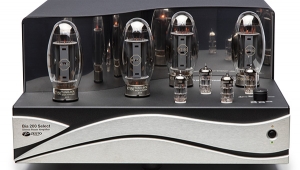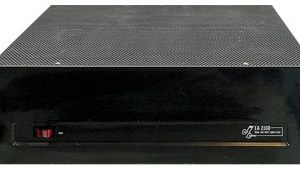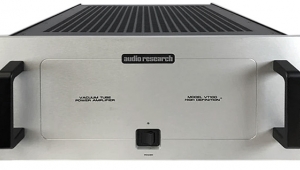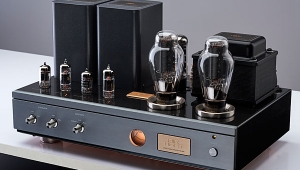| Columns Retired Columns & Blogs |
Sonic Frontiers Power 2 power amplifier Measurements
Sidebar 2: Measurements
The measurements of the Sonic Frontiers Power 2 were made in the unbalanced configuration, with selected readings taken in the balanced mode. All measurements were taken with the amplifier configured for an 8 ohm output tap (see more on this at the end of this Sidebar).
Following its preconditioning test, the Sonic Frontiers Power 2 was typically hot for a tube amplifier. Its voltage gain into 8 ohms measured 28.5dB, balanced or unbalanced. The input impedance measured 101k ohms (190k ohms balanced). DC offset was negligible at 0.4mV in the left channel, 0.5mV in the right. The Power 2 was noninverting, a positive-going input emerging positive at the output (pin 2 of the balanced input was wired as positive). The S/N ratio, unweighted (at 1W into 8 ohms), was 80.9dB over a 22Hz–22kHz bandwidth, 79dB from 10Hz to 500kHz (87.2dB, A-weighted). The output impedance of the Power 2 varied between 0.13 ohms and 0.17 ohms, the higher values occurring at 20kHz. This is a refreshingly low output impedance for a tube amplifier, suggesting a relatively consistent frequency response with varying loudspeaker loads.
Fig.1 shows the frequency response of the Power 2 at the conditions indicated. Note that, with our simulated real load, the deviations due to the amplifier's output impedance are relatively negligible, and the frequency response overall is more typical of a good solid-state design than of a tube amp. (The balanced frequency response, not shown, was virtually identical to the unbalanced.)

Fig.1 Sonic Frontiers Power 2, 8 ohm tap, frequency response at (from top to bottom at 5kHz): 1W into 8 ohms, 2W into 4 ohms, and 2.83V into simulated speaker load (right channel dashed, 0.5dB/vertical div.).
The output of the Power 2 in response to a 10kHz squarewave is shown in fig.2. This is a fair to good result; there is some visible overshoot, with just under two cycles of damped high-frequency ringing. The latter is also just barely visible on the 1kHz squarewave (not shown). Fig.3 shows the crosstalk. The separation is high, with the typical decrease at higher frequencies due to capacitive coupling between the channels.
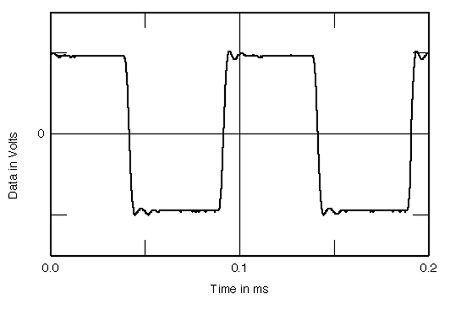
Fig.2 Sonic Frontiers Power 2, 8 ohm tap, small-signal 10kHz squarewave into 8 ohms.

Fig.3 Sonic Frontiers Power 2, crosstalk (from top to bottom at 20kHz): L–R, R–L (10dB/vertical div.).
THD+noise vs frequency is plotted in fig.4. This is a good result. The spikes visible in the left channel at 120Hz and 5kHz were repeatable and are likely noise-related, perhaps from a tube on its way out. (The spikes were not visible in the balanced result, which was otherwise identical to the unbalanced and is not shown.)
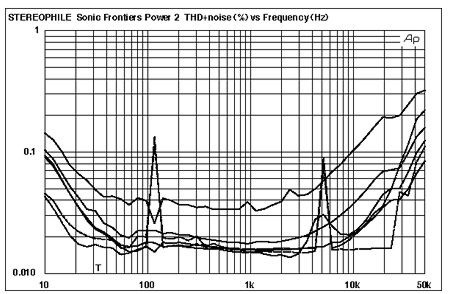
Fig.4 Sonic Frontiers Power 2, 8 ohm tap, THD+noise vs frequency at (from top to bottom at 10kHz): 4W into 2 ohms, 2W into 4 ohms, 1W into 8 ohms, 2.83V into simulated speaker load (right channel dashed).
The 1kHz THD+noise waveform at 2W out into 4 ohms (fig.5) is heavily second-harmonic. The same is true with other loads (not shown), though signs of higher-order distortion products became more evident into our simulated load (if still at a low level).

Fig.5 Sonic Frontiers Power 2, 8 ohm tap, 1kHz waveform at 2W into 4 ohms (top); distortion and noise waveform with fundamental notched out (bottom, not to scale).
The output spectrum resulting from a 50Hz input at 74W (2/3 rated power) into 4 ohms is shown in fig.6. The largest artifact is the second harmonic, at –62.6dB (about 0.075%). The 19+20kHz IM spectrum at 74W into 4 ohms is plotted in fig.7. The 1kHz intermodulation artifact is at –62.5dB (also about 0.075%); the distortion at 18kHz is –53.4dB (about 0.2%). The artifacts were slightly lower into 8 ohms, the single most prominent exception being –58dB (about 0.12%) at 1kHz (not shown).

Fig.6 Sonic Frontiers Power 2, 8 ohm tap, spectrum of 50Hz sinewave, DC–1kHz, at 74W into 4 ohms (linear frequency scale).

Fig.7 Sonic Frontiers Power 2, 8 ohm tap, HF intermodulation spectrum, DC–22kHz, 19+20kHz at 74W into 4 ohms (linear frequency scale).
The Power 2's THD+noise vs output power curves are shown in fig.8, its discrete clipping in Table 1.

Fig.8 Sonic Frontiers Power 2, distortion (%) vs output power into (from bottom to top at 40W): 8 ohms, 4 ohms, and 2 ohms.
Table 1 Sonic Frontiers Power 2 Clipping (1% THD+noise at 1kHz)
| Both Channels Driven | One Channel Driven | ||
| Load | W (dBW) | W (dBW) | |
| ohms | (L) | (R) | (L) |
| 8 | 133.9 (21.3) | 131.5 (21.2) | 141.5 (21.5) |
| (line) | 116V | 116V | 116V |
| 4 | 157.2 (19) | 149.7 (18.8) | 172.8 (19.4) |
| (line) | 116V | 116V | 116V |
| 2 | 111.1 (14.5) | ||
| (line) | 117V | ||
While the impedance of the output taps may be easily changed by going into the underside of the amplifier, this is not something we recommend a typical user do without dealer help. While we did not, therefore, measure the amplifier with the output taps configured for 2 or 4 ohms, Sonic Frontiers provided us with their measurements for the clipping levels into different loads with different tap settings. These indicated that the 8 ohm configuration for the output taps is probably the best choice from an objective (certainly a reasonable) standpoint. The single possible exception is a 2 ohm load at 20kHz.
The Sonic Frontiers Power 2's overall test-bench results are solid, particularly for a tube amplifier—the first tube amplifier I have measured in some time, in fact, that I plan to try out in my own system. I'm particularly impressed with its relatively benign output impedance, which will result in a relatively consistent performance with varying loudspeaker loads. There are few tube amplifiers I could use in good conscience to evaluate loudspeakers; the Power 2 is one of these.
I'd also like to compliment Sonic Frontiers on their slick packaging; the tubes are safely stored for shipment, but are still well organized and clearly marked for installation. They even include two screwdrivers and a bias-adjustment tool. While this probably isn't a big deal for most users, who will install the new set of tubes once and not have to bother to do it again for perhaps a couple of years (okay, maybe a year), reviewers do it constantly for different amps. For a couple of hours on the test bench, unpacking and plugging-in tubes can get to be a hassle. Not with the Power 2.—Thomas J. Norton
- Log in or register to post comments
